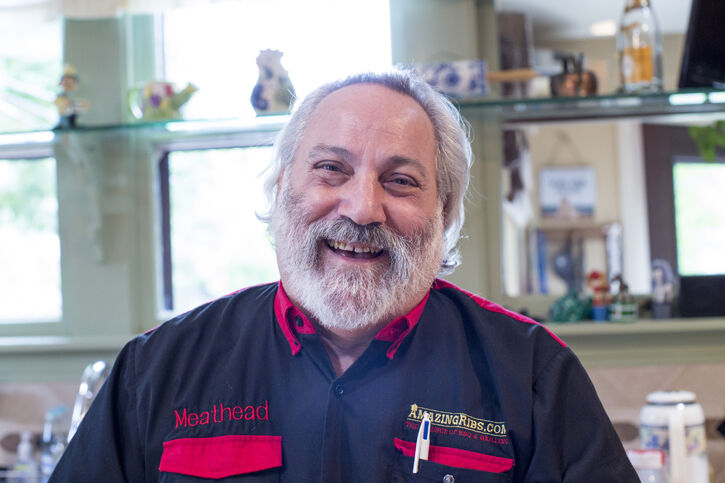
Art, Meat, Science
by Carlos Antonio Piñón (BFA 2017)
Right in his cozy Brookfield home, Meathead, formerly known as Craig Goldwyn (MFA 1977), runs the world’s most popular barbecue and grilling websites, gathering one million monthly visitors and exceeding Rachel Ray in the top 25 food websites in the United States. The Amazingribs.com headquarters houses grill after grill, each with a specific purpose. With so many tools available, it’s inconceivable how one could master the art of grilling. Luckily for amateurs, this SAIC alum spells it out step-by-step.
Meathead founded Amazingribs.com in 2005 after spending years as a wine critic for the Washington Post and Chicago Tribune. As a journalist, Meathead is no stranger to pursing truth. “We do an awful lot with food science and chemistry and physics,” he explains. “Every time you get into the kitchen, you start applying heat to protein, fat, and carbohydrates. It changes its molecular structure.” Meathead has weighed in on heaps of cooking myths and recipes, including the gas versus charcoal grill debate, and he even debunked the beer can chicken technique.
In 2010, Meathead abstained from meat for a month, adopting the name Potatohead, to protest the use of Confined Animal Feeding Operations (CAFO) in the animal industry. Along with ethical vegan Lisa Vager, he moderated a debate on Huffington Post titled “Meat or No Meat” contrasting arguments for and against eating meat. On his website, Meathead affirms, “I want to use my prominence in the food community and as a man whose reputation was built on cooking meat, to send a message to the factory farms that I think they can do better and I am willing to pay more for my meat if it is grown better.”

On his way to becoming the “Barbecue Whisperer,” Meathead left his undergraduate studies in 1971 to seek an assembly job in Detroit, Michigan. He made a trip to Chicago to see a one-man show of his former photography professor Jerry Uelsmann’s work at the Art Institute of Chicago. This experience led Meathead to apply to SAIC for graduate studies. “I wanted to take two images and combine them like Jerry did and create mythology and storytelling,” he recalls.
At the time, the Photography department was philosophically opposed to altering or even cropping photos, a position which alienated Meathead. His work found a home elsewhere. “When I saw what Sonia Landy Sheridan was doing with Generative Systems, working with copy machines, xerography, holography, thermographics, other technologies to create images, I saw a possibility for working with those to reach my goal,” he says.
Generative Systems, now known as the Art and Technology Studies department, was the only digital technology-based art program in the country at the time. "We were the small band who were runaways and break offs from the Photography and Painting departments, working with holograms and copy machines and fax machines," Meathead recounts. “We were just on the cutting edge. We were doing digital stuff when the word ‘digital’ was unknown.”
As the first group of art students to pursue digital art in a higher-education setting, Meathead and company curated a show called Unconventional Imaging Systems at Columbia College, attracting much attention. “We used to dream about the day when a musician could perform in a holographic shape, and now it’s happening.”
After receiving an MFA in 1977, Meathead taught art to chefs at Le Cordon Bleu College in Chicago, lecturing about shape, texture, and composition. To understand these core principles of art, Meathead assigned his students visits to the Art Institute of Chicago. He says, “I showed them a number of paintings and made them go to the Art Institute and come back and write about them. For many of them, they never set foot in the Art Institute [before].”
A high level of attention to technique is found throughout the grill master’s projects. Amazingribs.com’s reputation as the go-to resource for outdoor cooking is a direct result of Meathead’s careful study of the craft. “You need to learn your steps to be a great dancer, you need to learn how to stroke your instrument to be a great violinist, and once you master your craft, whether it’s photography, dance, music, whatever, then you can become the great artist.”
